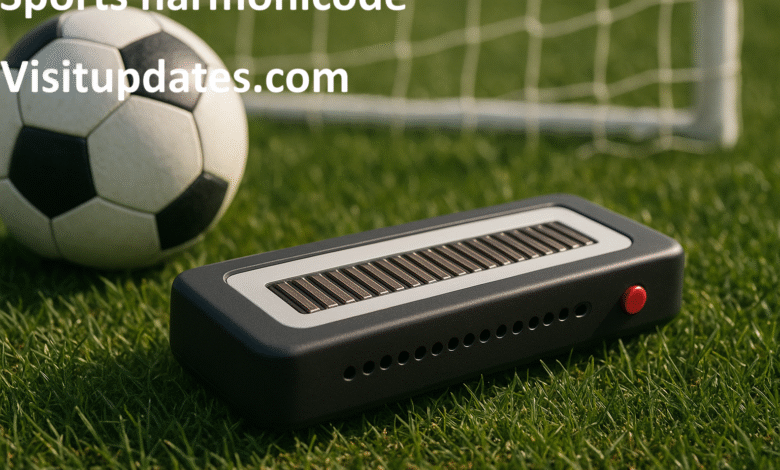Unveiling Sports Harmonicode: The Next Evolution in Athletic Performance and Data Precision

The world of Sports Harmonicode athletic training has witnessed countless innovations over the decades, from heart rate monitors to sophisticated GPS tracking systems. Yet, none have captured the imagination of sports scientists quite like Sports Harmonicode. This revolutionary approach represents a fundamental shift in how we understand and optimize human movement, blending principles from physics, biomechanics, and cutting-edge data analytics into a comprehensive performance system. As athletes and coaches search for that competitive edge, Sports Harmonicode emerges as a game-changing methodology that decodes the hidden rhythms within athletic motion.
What Exactly Is Sports Harmonicode?
Sports Harmonicode is an innovative analytical framework that applies harmonic principles to athletic performance optimization. At its foundation, this methodology examines movement patterns through the lens of frequency, oscillation, and resonance—concepts traditionally associated with physics and music theory. The system analyzes how an athlete’s body moves in natural rhythmic patterns, identifying the “harmonic code” that governs efficient motion. By understanding these fundamental patterns, coaches and athletes can fine-tune techniques to align with the body’s natural frequencies, ultimately reducing energy waste and maximizing output.
The term “harmonicode” itself reflects this dual nature—combining harmonic analysis with systematic coding of movement data. Think of it as translating the complex symphony of athletic motion into readable, actionable information. Advanced sensors and motion capture technology collect thousands of data points during performance, which are then analyzed to reveal the underlying harmonic patterns that distinguish elite execution from average performance. This approach moves beyond simple metrics like speed or distance, diving deep Sports Harmonicode into the qualitative aspects of how movement happens.
The Science Behind the System
The scientific foundation of Sports Harmonicode rests on biomechanical principles that have been understood for decades but never applied with such precision. Human movement naturally operates in oscillatory patterns—from the pendulum-like swing of limbs to the rhythmic contractions of muscles during repetitive actions. These movements generate specific frequencies that can be measured and analyzed, much like sound waves or vibrations in mechanical systems. When these frequencies align optimally, athletes achieve what sports scientists call “movement harmony,” where every action flows efficiently with minimal energy loss.
Research in this field has demonstrated impressive accuracy rates, with harmonic motion analysis achieving approximately ninety-four percent correlation with traditional laboratory biomechanics assessments. This level of precision makes the technology suitable not just for performance enhancement but also for rehabilitation applications where precise movement analysis is critical. The methodology incorporates advanced machine learning algorithms that identify patterns across millions of movement cycles, establishing baseline harmonic signatures for different athletic activities and individual athletes.
Core Components of Sports Harmonicode Technology
The technological ecosystem supporting Sports Harmonicode consists of multiple integrated components working in concert. Wearable sensors form the primary data collection layer, capturing motion metrics including acceleration, angular velocity, muscle activation patterns, and joint angles in real-time. These devices have evolved significantly from bulky laboratory equipment to lightweight, unobtrusive sensors that athletes can wear during actual competition without performance interference. The sensors measure not just what movements occur, but how they occur—capturing the subtle variations in timing and force application that distinguish efficient from inefficient technique.
Beyond hardware, sophisticated software platforms process the collected data through proprietary algorithms designed to identify harmonic patterns. These systems generate detailed visualizations that transform raw numbers into intuitive representations of movement quality. Coaches can view oscillation graphs, frequency spectrums, and resonance maps that highlight exactly where an athlete’s technique aligns with or deviates from optimal patterns. The software also includes machine learning capabilities that continuously improve analysis accuracy by learning from expanding datasets of elite athletic performances across various sports disciplines.
Applications Across Different Sports

Sports Harmonicode has found valuable applications across diverse athletic disciplines, though certain sports benefit more dramatically than others. Cyclical sports like running, swimming, and rowing show particularly strong results because their repetitive motion patterns make harmonic analysis especially relevant. Runners, for instance, can optimize their stride frequency and ground contact time to achieve what researchers call “harmonic stride,” where each step efficiently transfers energy forward with minimal vertical oscillation. Elite distance runners often naturally develop this efficient pattern through years of training, but Sports Harmonicode accelerates the learning curve significantly.
Team sports and technique-intensive activities also benefit substantially from harmonic analysis. In baseball, pitchers can analyze the rotational frequencies of their throwing motion to maximize velocity while minimizing injury risk. Basketball players use the system to perfect their shooting mechanics, ensuring consistent release timing and optimal arc trajectory. Even in combat sports like boxing, fighters analyze punch delivery patterns to increase power generation through better kinetic chain coordination. The adaptability of harmonic principles means virtually any sport involving human movement can extract value from this analytical approach.
Biomechanical Advantages and Performance Gains
The primary advantage of Sports Harmonicode lies in its ability to optimize biomechanics at a level previously unattainable with conventional training methods. By identifying inefficiencies in movement patterns, athletes can make targeted adjustments that yield significant performance improvements. These gains manifest in multiple ways: increased power output through better force transfer, enhanced endurance by reducing wasted energy, improved speed through optimized movement frequencies, and greater consistency by establishing repeatable harmonic patterns. Athletes report that once they understand their optimal harmonic signature, executing techniques becomes more intuitive and less mentally taxing.
Injury prevention represents another crucial benefit of harmonic analysis. Many sports injuries result from repetitive stress caused by poor biomechanics over thousands of movement cycles. When athletes operate outside their natural harmonic frequencies, certain muscles and joints experience disproportionate loading, creating conditions for overuse injuries. Sports Harmonicode identifies these problematic patterns early, allowing for corrective interventions before tissue damage occurs. Physical therapists increasingly incorporate harmonic analysis into rehabilitation protocols, using frequency data to ensure patients rebuild movement patterns correctly rather than reinforcing compensatory habits.
Data Precision and Analytical Depth
The level of data precision achievable with Sports Harmonicode far exceeds traditional performance metrics. While conventional systems might record that a runner completed a mile in six minutes, harmonic analysis reveals the intricate details of how those six minutes were achieved. Did the athlete maintain consistent stride frequency? Were there micro-variations in ground contact time that indicate fatigue? How did breathing patterns synchronize with step cadence? These granular insights allow for optimization at scales previously invisible to coaches and athletes.
Advanced analytics platforms generate comprehensive reports that translate complex harmonic data into actionable coaching points. These reports often include comparison analyses showing how an athlete’s current performance compares to their historical baseline, to peer competitors, or to elite benchmarks in their sport. Trend analysis identifies whether training interventions are producing the desired harmonic shifts or if alternative approaches are needed. The system also flags anomalies—unusual deviations from typical patterns that might indicate emerging injury risks or technical flaws requiring immediate attention.
Integration with Training Programs
Successfully implementing Sports Harmonicode requires thoughtful integration into existing training frameworks rather than wholesale replacement of proven methodologies. Progressive coaches treat harmonic analysis as a powerful supplementary tool that enhances traditional training rather than competing with it. A typical integration begins with baseline assessment, where athletes perform standard activities while wearing sensors to establish their current harmonic profiles. This data becomes the reference point for measuring future progress and identifying initial optimization opportunities.
Training protocols then incorporate specific drills designed to reinforce optimal harmonic patterns. These exercises might seem simple—repetitive movements performed at prescribed frequencies—but they systematically retrain neuromuscular systems to operate more efficiently. Athletes receive real-time biofeedback during these sessions, learning to sense when their movements align with target frequencies. Over time, correct patterns become automatic, integrated into muscle memory without conscious thought. Periodic reassessments track progress and adjust training focuses as athletes master certain aspects and move toward new optimization targets.
Challenges and Considerations
Despite its impressive capabilities, Sports Harmonicode implementation faces several practical challenges that organizations must navigate. The initial investment in quality sensors, software platforms, and training for staff represents a significant financial commitment that may be prohibitive for amateur programs or individual athletes. Additionally, interpreting harmonic data requires specialized knowledge—coaches need education in both the theoretical foundations and practical applications of frequency analysis. Without this expertise, there’s risk of misinterpreting data or making counterproductive training decisions based on incomplete understanding.
Data overload presents another legitimate concern. The wealth of information generated by comprehensive harmonic analysis can become overwhelming rather than enlightening if not properly filtered and prioritized. Athletes and coaches must develop strategies for focusing on the most relevant metrics for their specific goals while avoiding paralysis by analysis. Some users find that excessive focus on data diminishes intuitive coaching or athlete self-awareness, creating dependence on technology where traditional coaching wisdom might suffice. The most successful implementations balance technological insights with experiential knowledge and maintain space for human intuition in the training process.
The Future of Athletic Performance Analysis
As Sports Harmonicode continues evolving, several exciting developments appear on the horizon. Artificial intelligence integration will likely expand dramatically, with systems providing increasingly sophisticated predictive analytics that forecast performance outcomes based on harmonic trends. Imagine a platform that not only analyzes current technique but predicts optimal competition strategies based on an athlete’s harmonic profile and environmental conditions. Real-time coaching applications may emerge, with athletes receiving instant feedback through earpieces during actual competition, though this raises questions about maintaining sport integrity and competitive fairness.
Accessibility will likely improve as technology costs decrease and user interfaces become more intuitive. What currently requires expensive equipment and specialized expertise may eventually become available through smartphone applications and affordable consumer devices. This democratization could revolutionize youth sports development, allowing talented young athletes to access world-class analytical tools regardless of their economic circumstances. Research will undoubtedly expand the theoretical foundations, discovering new applications of harmonic principles and refining our understanding of optimal movement patterns across different populations and athletic contexts.
Conclusion
Sports Harmonicode represents more than just another technological innovation in athletic training—it embodies a fundamental reconceptualization of human movement analysis. By revealing the hidden harmonic patterns that govern efficient motion, this methodology provides athletes and coaches with unprecedented insights into performance optimization. The system’s combination of rigorous scientific principles, sophisticated technology, and practical application has already demonstrated its value across numerous sports disciplines, with documented improvements in performance metrics and injury prevention.
As the field matures and accessibility increases, Sports Harmonicode seems poised to become a standard component of serious athletic training programs. The athletes who embrace this approach gain a significant competitive advantage, optimizing their biomechanics with precision impossible through traditional methods alone. For the broader sports community, this evolution signals an exciting future where data-driven insights and human athleticism converge, pushing the boundaries of what’s possible in human performance. The harmonic revolution in sports science has begun, and its impact will resonate throughout athletics for generations to come.
YOU MAY ALSO READ
UK Braced for Significant Snowstorm Bringing Potential White Christmas



